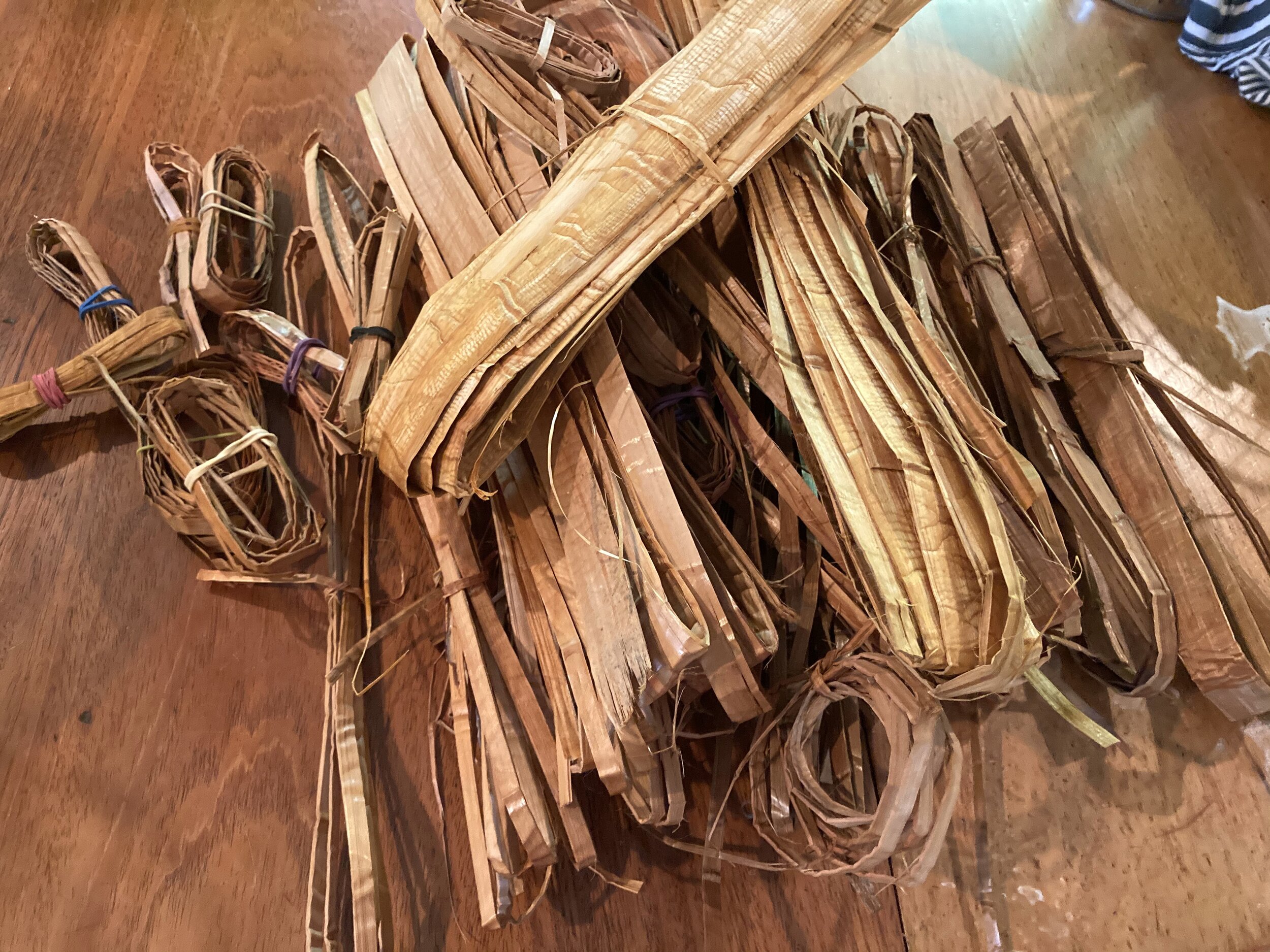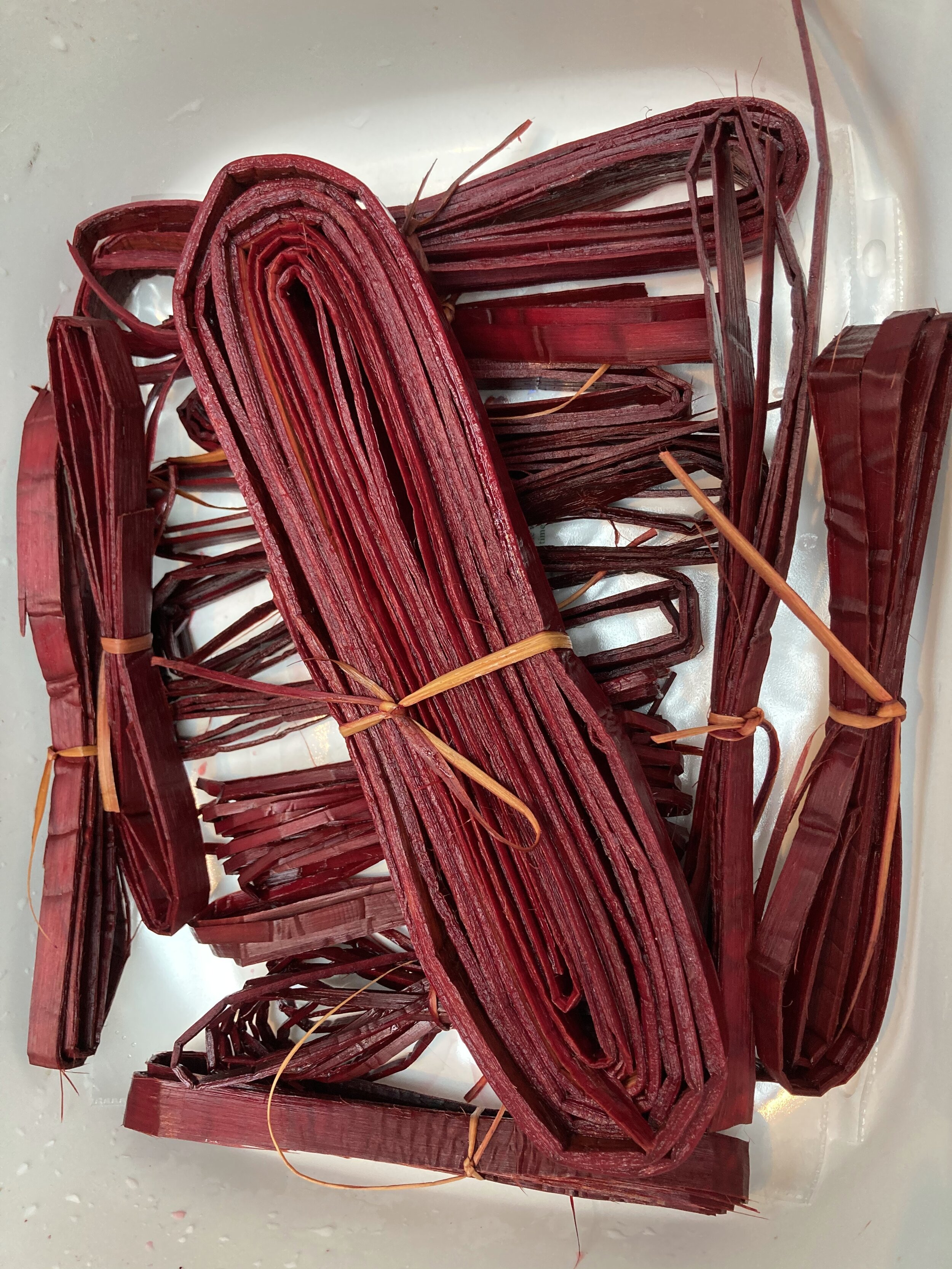Cedar Bark Dyeing - Red
I started experimenting last year with dyeing cedar bark strips using plants. Bark strips from Western redcedars (Thuja Plicata) and yellow cedars (Cupressus Nootkatensis) have been harvested for a wide variety of uses including clothing, basketry, mats, etc. by the Indigenous of coastal Pacific Northwest for thousands of years. This dyeing has mainly been for First Nation friends and also to support the cedar bark basketry that I have been learning with them. Not all of my dyeing is meant to be shared publicly but when it came to wanting to learn how to dye cedar bark, there wasn’t much publicly available. So here below is what I’ve learned and hopefully this can help support others wanting to dye their own cedar.
Please note: harvesting cedar bark from live trees takes training, knowledge and a deep respect for the trees and forests. Western redcedars and yellow cedars are not adapting well to Climate Change and over-harvesting of bark can kill trees, especially if they are already stressed. If you are trained and are proceeding with cedar bark harvesting, please make sure you are familiar with the practices, teachings, protocols and permissions of the People’s land you are on as we work together to undue and heal the harm of colonialism.
Materials involved: cedar bark strips, alum, tannin and cochineal.
Photo: Oregon Grape root shavings
These posts are going to focus on the intersection of modern natural knowledge and materials with cedar bark, and not traditional historic dyeing apart from one article available here. Published in 1916, it describes an interview with a man named Chem/Steve from the Nuu-chah-nulth First Nation (described as “'the Clayoquots”) on the western side of Vancouver Island. Chem shares the traditional sources of five colours on cedar bark and grasses that his family uses:
Black: “The black, and it is a black that will not fade, is obtained by covering the rushes, grasses or bark with the black mud of the swamps, which gives a lasting jet equal to any imported dye”
Red: “Bark of the alder”
Pink: “Weaker solution of the same bark”
Brown: “Familiar tanbark* of the hemlock”
Yellow: “Boiled out root of the Oregon Grape”
I wanted to share this publicly-available example of the rich, ancient history of textile arts on this coast: a history which very much includes natural dyeing. Thank you Chem for sharing your knowledge with the world.
*Tanbark: describes bark that has been bruised and broken usually as a byproduct of forestry, it can be used for various applications including hide tanning.
“Dye, dye, halo eumtux dye. Nika klutchmen mamook conoway iktas coqua ahnkutty. (Translation: Dye, dye, I don’t know what dye is. My women made these articles as the Indigenous People used to do in the old times.)”
200 grams starting material
A friend passed over some bundles of cedar bark of various widths (1/4”, 1/2” and 1’’) so I got to work. First thing I did was weigh them all.
So I wasn’t sure how to use alder bark to get red so I decided to go with what I did know: cochineal. I was inspired by my friend Stephanie Leon Riedl who got a true red on cedar without any pH adjustment. It turns out the acidic nature of cedar ensures a deep red with cochineal, unlike wools which usually give fuchsias. Thank you Stephanie for sharing this knowledge and for helping provide feedback and ideas on this blog entry.
The soak
I started by soaking the cedar in (just) warm water for about an hour to loosen it up and dissolve away some of the sap. After this, I took the cedar out and dissolved in 15% Weight of Fiber (WOF) of alum (60 grams) and 1 tbsp of tannin. The tannin I added to help the mordant and the dye absorb into the plant material.
Ground up the cochineal
Cochineal (Dactylopius coccus) is a scale insect native to South America and southeastern US. It contains a powerful dye - carmine, which is pH sensitive and gives deep, stable shades of reds and pinks to vibrant purples. I wanted to experiment and use as little as possible to get a bright red purely for cost purposes and reduce waste. I order my cochineal and most of my dye supplies I don’t harvest myself from Maiwa.
Colour change
I poured out the alum-infused water, rinsed the cedar and set up a new pot with warm water. I then started with only 2% WOF (4 grams) of cochineal to create the dye vat. I let the cochineal simmer in the pot for about an hour and then added in the cedar and let the pot simmer for another hour. The colour came out a fairly dull pale red, so I redid this same process with the following totals until I was happy with the colour:
4% WOF (8 grams)
8% WOF (16 grams)
16% WOF (32 grams)
The right balance
At 16% WOF, the colour was finally a deep satisfying shade of red.
Results
Final product was deep, even red. The lushness of the red did fade once dry though. The bundles were retied and passed back to the weaver.
Example
Here is a woven basket with cedar bark I dyed with cochineal.
Results:
These are the final dried bundles ready to go back to the weaver.
General tips:
Do not add cream of tartar to your mordant when dyeing with cedar (as is often done with wools). This inhibits the update of colour and cannot be reversed no matter how much cochineal is added. This photo on right is an example of the colour I got with cochineal with alum and cream of tartar. Sadness.
Keep wool and cedar apart for dyeing. The cedar releases a lot of sap which will gum up the wool. After multiple dye pots with cedar, my pots started to build up a film and I think I might get a separate setup to ensure the sappy film doesn’t effect future wool dyeing.
Cedar and dye material can be freely added into the same dye pot (i.e., dye material won’t stick to the cedar). The cedar seemed to take the colour evenly and easily.
Changing the pH of a dyevat with cedar bark and cochineal does not change the colour of the bark (as it does with wool). In fact, by experimenting with shifting the pH up, I completely shredded some bark and rendered it pretty much useless.











